Related Research Articles
Gaius Suetonius Tranquillus, commonly referred to as Suetonius, was a Roman historian who wrote during the early Imperial era of the Roman Empire.

A Roman villa was typically a farmhouse or country house built in the Roman Republic and the Roman Empire, sometimes reaching extravagant proportions.

Gaius Plinius Secundus, called Pliny the Elder, was a Roman author, naturalist and natural philosopher, and naval and army commander of the early Roman Empire, and a friend of the emperor Vespasian. He wrote the encyclopedic Naturalis Historia, which became an editorial model for encyclopedias. He spent most of his spare time studying, writing, and investigating natural and geographic phenomena in the field.

Mount Vesuvius is a somma-stratovolcano located on the Gulf of Naples in Campania, Italy, about 9 km (5.6 mi) east of Naples and a short distance from the shore. It is one of several volcanoes which form the Campanian volcanic arc. Vesuvius consists of a large cone partially encircled by the steep rim of a summit caldera, caused by the collapse of an earlier and originally much higher structure.

Gaius Plinius Caecilius Secundus, born Gaius Caecilius or Gaius Caecilius Cilo, better known as Pliny the Younger, was a lawyer, author, and magistrate of Ancient Rome. Pliny's uncle, Pliny the Elder, helped raise and educate him.
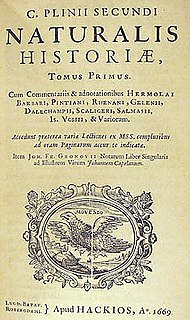
The Natural History is a work by Pliny the Elder. The largest single work to have survived from the Roman Empire to the modern day, the Natural History compiles information gleaned from other ancient authors. Despite the work's title, its subject area is not limited to what is today understood by natural history; Pliny himself defines his scope as "the natural world, or life". It is encyclopedic in scope, but its structure is not like that of a modern encyclopedia. It is the only work by Pliny to have survived, and the last that he published. He published the first 10 books in AD 77, but had not made a final revision of the remainder at the time of his death during the AD 79 eruption of Vesuvius. The rest was published posthumously by Pliny's nephew, Pliny the Younger.

Arria was a woman in ancient Rome. Her husband, Caecina Paetus, was ordered by the emperor Claudius to commit suicide for his part in a rebellion but was not capable of forcing himself to do so. Arria wrenched the dagger from him and stabbed herself, then returned it to her husband, telling him that it didn't hurt. Her story was recorded in the letters of Pliny the Younger, who obtained his information from Arria's granddaughter, Fannia.

Poppaea Sabina, also known as Ollia, was a Roman Empress as the second wife of the Emperor Nero. She had also been wife to the future emperor Otho. The historians of antiquity describe her as a beautiful woman who used intrigues to become empress.
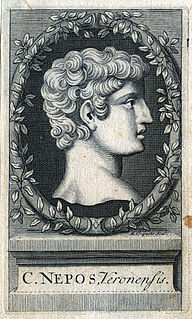
Cornelius Nepos was a Roman biographer. He was born at Hostilia, a village in Cisalpine Gaul not far from Verona.

The Villa of the Papyri was an ancient Roman villa in Herculaneum, in what is now Ercolano, southern Italy. It is named after its unique library of papyri, discovered in 1750. The Villa was considered to be one of the most luxurious houses in all of Herculaneum and in the Roman world. Its luxury is shown by its exquisite architecture and by the very large number of outstanding works of art discovered, including frescoes, bronzes and marble sculpture which constitute the largest collection of Greek and Roman sculptures ever discovered in a single context.
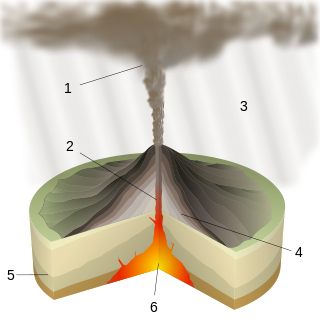
Plinian eruptions or Vesuvian eruptions are volcanic eruptions marked by their similarity to the eruption of Mount Vesuvius in 79 AD, which destroyed the ancient Roman cities of Herculaneum and Pompeii. The eruption was described in a letter written by Pliny the Younger, after the death of his uncle Pliny the Elder.
Pomponianus was a Roman Senator who was present at Stabiae during the eruption of Mount Vesuvius in AD 79. He attempted to escape by ship, but was stuck on shore because the prevailing wind was not favorable.
Miseno is one of the frazioni of the municipality of Bacoli in the Italian Province of Naples. Known in ancient Roman times as Misenum, it is the site of a great Roman port.

Publius Vedius Pollio was a Roman of equestrian rank, and a friend of the Roman emperor Augustus, who appointed him to a position of authority in the province of Asia. In later life he became infamous for his luxurious tastes and cruelty to his slaves – when they displeased him, he had them fed to "lampreys" that he maintained for that purpose, which was deemed to be an exceedingly cruel act. When Vedius tried to apply this method of execution to a slave who broke a crystal cup, Emperor Augustus was so appalled that he not only intervened to prevent the execution but had all of Pollio's valuable drinking vessels deliberately broken. This incident, and Augustus's demolition of Vedius's mansion in Rome he inherited in his will, were frequently referred to in antiquity in discussions of ethics and of the public role of Augustus.
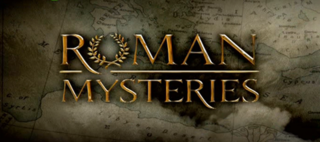
Roman Mysteries is a television series based on the series of children's historical novels by Caroline Lawrence. It is reportedly the most expensive British children's TV series to date at £1 million per hour.
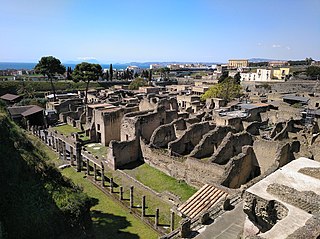
Herculaneum was an ancient town, located in the modern-day comune of Ercolano, Campania, Italy. Herculaneum was buried under volcanic ash and pumice in the eruption of Mount Vesuvius in AD 79.

The Epistulae are a series of personal missives by Pliny the Younger directed to his friends and associates. These Latin letters are a unique testimony of Roman administrative history and everyday life in the 1st century. The style is very different from that in the Panegyricus, and some commentators maintain that Pliny initiated a new genre: the letter written for publication. This genre offers a different type of record than the more usual history; one that dispenses with objectivity but is no less valuable for it. Especially noteworthy among the letters are two in which he describes the eruption of Mount Vesuvius in 79 during which his uncle Pliny the Elder died, and one in which he asks the Emperor for instructions regarding official policy concerning Christians.

Of the many eruptions of Mount Vesuvius, a major stratovolcano in southern Italy, the most famous is its eruption in 79 AD, which was one of the deadliest in European history. The eruption of Mount Vesuvius in 79 AD has been called one of the most well-known volcanic eruptions in history.
The gens Fannia was a plebeian family at ancient Rome, which first appears in history during the second century BC. The first member of this gens to attain the consulship was Gaius Fannius Strabo, in 161 BC.

The gens Triaria was an obscure plebeian family at ancient Rome. Only a few members of this gens are mentioned by Roman writers, but two of them attained the consulship in imperial times. Other Triarii are known from inscriptions.
References
- 1 2 3 Pliny the Younger (1909). Eliot, Charles W. (ed.). "Letters LXV. To Tacitus". The Harvard Classics. IX Part 4. New York: Bartleby.
{{cite journal}}: Cite journal requires|journal=(help) - 1 2 Shelton, Jo-Ann (2013). The Women of Pliny's Letters: Women of the ancient world (illustrated ed.). Routledge. pp. 156–7. ISBN 9780415374286.